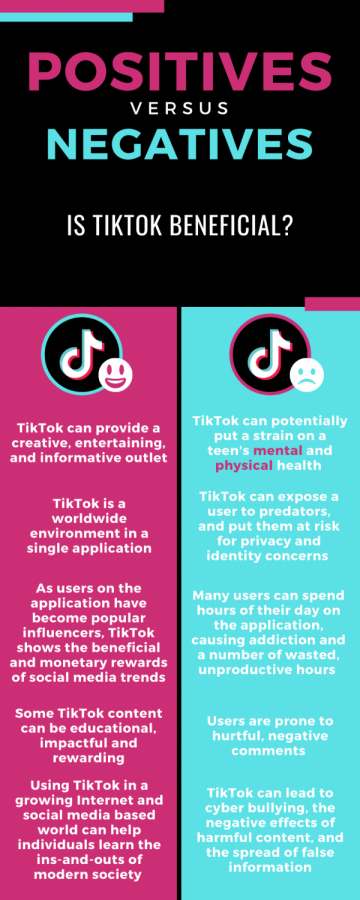The Negatives of TikTok
January 4, 2021
Social media applications like TikTok provide users with entertainment, a creative outlet, and useful information, but the cons of these new forms of social media continue to grow. TikTok, which was created in September of 2016, recently sprung into the spotlight of everyday use for many teenagers across the globe. With the exponential growth of the application, the harms are more evident than ever before.
The epitome of the twenty-first century lays deeply within technology and cyber networking. The newest addition to the widely used category of social media — already consisting of Instagram, Facebook, Snapchat, and Twitter — is TikTok. TikTok is a Chinese video-sharing social networking service owned by ByteDance. The social media platform is used to make a variety of short videos with genres like dance, comedy, and education that have a duration from 3 to 60 seconds.
 Although many types of research claim that TikTok can boost a child’s self-esteem, share convenient information, educate, and connect alike individuals among many other beneficial bases, one of the most prevalent concerns in regards to this platform is the effect it can potentially have on one’s mental health.
Although many types of research claim that TikTok can boost a child’s self-esteem, share convenient information, educate, and connect alike individuals among many other beneficial bases, one of the most prevalent concerns in regards to this platform is the effect it can potentially have on one’s mental health.
With the growth of influence and followers, hate speech and negative comments come flushing into an individual’s comment section. Negative feedback to a video can severely impact one’s self-esteem and confidence, even resulting in self-harm or body image issues. In severe cases, when a user receives hateful comments on a post they previously thought would be impacting and sincere, a user could be left for years later debating whether or not they should try their best, step out of their comfort zone, or even move forward with something they have worked on. Additionally, TikTok can provide users with the opportunity to engage in cyberbullying. Some students make fun of each other’s videos and make videos just to ridicule their fellow students.
Like many social media platforms, there is always a risk of unwanted exposure, especially for minors. Combined with the growing number of users of all ages, TikTok can potentially pose harm to youth. Some videos can come across as triggering content on the app that could promote issues like exclusion, eating disorders, and even self-harm. When mature individuals send explicit messages and images to children, the entire application can spiral into a problematic downfall. However, it is not just on TikTok where user experience these distressing situations. Many social media applications have reported predatory-like behavior, but it is on TikTok where the influences of the harm are seen often. TikTok allows for exposure, unlike other social media networks as TikTok allows users to watch and upload 60-second videos. Subsequently, a “For You” page is created for users based on their interests and interactions with similar videos.
As a result of the engaging content, students often spend a lot of time on TikTok, even some spend hours a day. TikTok’s “For You” page and everlasting content send an “endless stream” of material for viewers to watch. This can cause users to spend such a long time on the app that participants might even become addicted, strain their eyesight, and lower physical activity and workload productivity.
TikTok can harm users’ privacy by filming in areas that reveal their homes and alike locations. Many young users even try to show off luxury items that can put them at risk for theft. By using tracking applications, intense research, and a user’s TikTok videos, a devoted malicious individual will easily be able to pinpoint the location coordinates of the individual’s home. More physical safety concerns lie with dangerous trends, challenges, and the desire to acquire more likes by causing harm to oneself or others.
Although there are some positives outcomes of the application, there are many negatives that come with opening TikTok and seeing the application load on your screen. Many experience mental health deficits, addiction, physical harm, privacy exposure, and bullying.